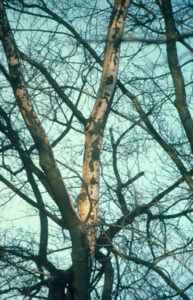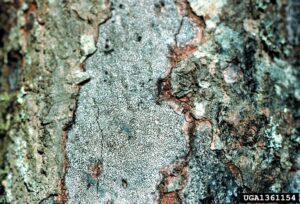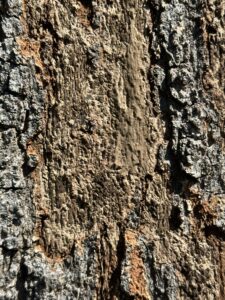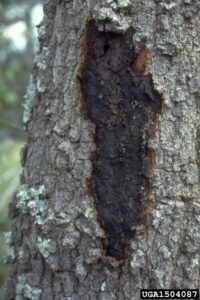Hypoxylon canker is a common disease of mature hardwood trees both in landscapes and in natural wooded areas. The disease, caused by the wood decay fungus Biscogniauxia (formerly Hypoxylon), is most frequently observed in oak tree species, but can also cause dieback in pecan, hickory, golden rain tree, sycamore, maple, beech, birch, elm, willow, basswood, hornbeam, and others.
- Figure 1: Significant bark loss of a mature oak tree due to Hypoxylon canker. Photo Credit: Purdue PPDL
- Figure 2: Stroma of Biscogniauxia developing on wood below the bark. The color of the stroma is white to gray initially. Photo Credit: Terry S. Price, Georgia Forestry Commission, Bugwood.org
The fungus may colonize tree bark and sapwood months before symptoms develop, though it is regarded as a weak pathogen and does not cause disease in healthy, vigorous trees due to the natural defenses present. Stress, in the form of excessive heat, drought, root damage, chemical injury, or insect injury, is necessary before Biscogniauxia starts to cause disease symptoms. Initially, individual branches or sections of the canopy may begin to turn yellow or die back, but as the summer progresses, foliage may fall prematurely.
- Figure 3: A Biscogniauxia stroma turns from white to a rusty-brown color over time. Photo Credit: Purdue PPDL
- Figure 4: A mature stroma of Biscogniauxia will eventually turn black. Photo Credit: USDA Forest Service – Region 8 – Southern , USDA Forest Service, Bugwood.org
As it continues to grow within the tree, pressure develops within the bark, which cracks and eventually falls from the tree, exposing the fungal growth below and creating a pile of bark at the base of the trunk. In severely affected trees bark may be lost from most of the tree. If the fungus surrounds the main trunk it can girdle it, eventually killing the tree. The exposed fungal growth initially appears white which will turn to gray, red-brown, then black as time progresses. Biscogniauxia produces dry, dusty spores which are spread primarily by wind. It is an internal wood decay fungus and will reduce the overall integrity of the tree, especially when located on the main trunk. Once found, we recommend evaluating the structural stability of the tree as it will be more prone to failure and wind throw.
There are no fungicides labeled to manage Hypoxylon canker and it would be impossible to try and manage for the pathogen itself since it is already widespread in the natural environment. Avoiding damage from Hypoxylon depends on stress mitigation, including providing supplemental water during hot and dry periods, mulching the root zone to prevent soil moisture loss (and to avoid competition for water by turfgrass), and providing adequate plant nutrition.



